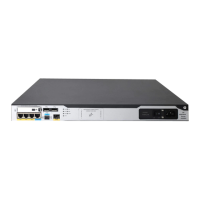114
Ste
Command Remarks
3. Set the maximum size of each
join or prune message.
jp-pkt-size size The default setting is 8100 bytes.
Enabling BFD for PIM
PIM uses hello messages to elect a DR for a shared-media network. The elected DR is the only multicast
forwarder on the shared-media network.
If the DR fails, a new DR election process does not start until the DR ages out. In addition, it might take
a long period of time before other routers detect the link failures and trigger a new DR election. To start
a new DR election process immediately after the original DR fails, enable BFD for PIM on a shared-media
network to detect link failures among PIM neighbors.
You must enable BFD for PIM on all PIM-enabled routers on a shared-media network. For more
information about BFD, see High Availability Configuration Guide.
Before you configure this feature on an interface, be sure to enable PIM-DM or PIM-SM on the interface.
To enable BFD for PIM:
Ste
Command
Remarks
1. Enter system view.
system-view N/A
2. Enter interface view.
interface interface-type interface-number N/A
3. Enable BFD for PIM.
pim bfd enable
By default, BFD is disabled for
PIM.
Enabling SNMP notifications for PIM
When the SNMP notification feature is enabled, PIM generates notifications if important PIM events
occur. The notifications are sent to the SNMP module. The output rules for PIM notifications depend on
the SNMP notification configuration.
For more information about SNMP notifications, see Network Management and Monitoring
Configuration Guide.
To enable SNMP notifications for PIM:
Ste
Command
Remarks
1. Enter system view.
system-view N/A
2. Enable SNMP notifications for
PIM.
snmp-agent trap enable pim
[ candidate-bsr-win-election |
elected-bsr-lost-election |
neighbor-loss ] *
By default, SNMP notifications for
PIM are enabled.
Displaying and maintaining PIM
Execute display commands in any view and reset commands in user view.

